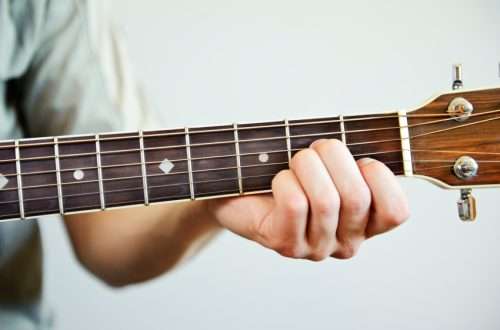
Basic chords for beginner guitarists
Contents
Introductory information
Any person who tries to learn to play the guitar wants to learn the songs of their favorite artists first. The vast majority of popular acoustic guitar compositions are composed of popular chords played in different sequences and rhythmic patterns. Therefore, if you learn and master them, then you will be able to play almost any song from the repertoire of Russian and foreign performers. This article presents all existing chords for beginners, as well as a detailed analysis of each of them.
What is a chord?
First of all, you need to understand – what is a chord in general? This term is common to all music theory – and the easiest way to explain it is as a musical triad. In fact, this is the simultaneous sounding of three notes lined up with each other in a certain way. At the same time, it is important that they play simultaneously and not be a sequence of tones – it is under this condition that a chord is formed from three notes.
Of course, in addition to simple chords, there are many others that are four, five or more sounds, but this article will not touch on them. Beginner Chords is a triad and nothing more.
Each triad consists of two musical intervals – a major and a minor third, going in a different order for a minor and a major chord. On the guitar, fortunately, this system is greatly simplified by the presence of chord forms and fingering, so a beginner guitarist does not need to delve into this issue in order to play his favorite pieces.
What are the chords?
How to read a chord fingering?
As mentioned above, playing chords does not require knowledge and understanding of how they are built, and you do not need to look for them on the fretboard – everything has long been done and recorded in the form of special schemes – fingerings. By going to any resource with selected compositions, under the names of chords, you can see a picture with a grid and dots in different places. This is the chord diagram. First, let’s figure out what kind of network it is.
In fact, these are the four frets of a guitar neck drawn. The six vertical lines represent the six strings, while the horizontal lines separate the frets from each other. Thus, in the basic fingering there are four frets – plus “zero”, open – as well as six strings. The dots represent the frets and the string that is pressed in the chord.
In addition, many points are numbered among themselves, and these numbers correspond to the fingers with which you need to pinch the string.
1 – Index finger; 2 – Middle finger; 3 – Ring finger; 4 – Little finger.
An open string is either not indicated in any way, or is marked with a cross or the number 0.
How to play chords?
Proper hand positioning is essential for playing chords correctly. Relax your left hand and place the neck of the guitar in it so that the back of the neck rests on the thumb and the fingers are against the strings. No need to grab the neck and squeeze it – try to keep the left hand always relaxed.
Bend your fingers and hold any chord with their pads. If you are doing this for the first time, then most likely you will not be able to properly tighten the strings. Press down on the strings until you get a crisp sound without any rattling, but don’t overdo it and don’t press too hard against the fretboard or the sound will be severely distorted. Most likely, the pads will start to hurt – and this is normal, just keep playing chords until the fingers get calluses and they get used to the fact that the steel cuts and rubs them. Do not put your fingers on the fret nut, otherwise you will get a nasty rattle.
When you learn how to change chords and play songs with confidence – try on some triads to grab the neck a little with your hand, throwing your thumb over the neck. This will give you more control over your playing, as well as muting the bottom bass string for clear D or Am chords. Remember only one thing – during the games, all hands should be relaxed and not overstrained.
List of chords for beginners
And now we come to the most important part of the article – the list and analysis of chords for beginners. There are eight of them in total, and no other skills are required to play them other than pinching the strings. They are played without problems on the first three frets, and it is from them that most of the popular songs consist.
Chord Am – A minor
Staging:
| Finger | String | Lad |
| Pointing | 2 | 1 |
| Medium4 | 4 | 2 |
| Nameless | 3 | 2 |
| Little finger | — | — |
Chord A – A major
Staging:
| Finger | String | Lad |
| Pointing | 4 | 2 |
| Average | 3 | 2 |
| Nameless | 2 | 2 |
| Little finger | — | — |
D chord – D Major
Staging:
| Finger | String | Lad |
| Pointing | 3 | 2 |
| Average | 1 | 2 |
| Nameless | 2 | 3 |
| Little finger | — | — |
It is important to note that for the pure sound of this triad, you need to hit the strings starting from the fourth – as from the tonic string. The rest, while ideally, should not sound.
Dm chord – D minor
Staging:
| Finger | String | Lad |
| Pointing | 1 | 1 |
| Average | 3 | 2 |
| Nameless | 2 | 3 |
| Little finger | — | — |
As with the previous chord, only the first four strings need to be struck for a clear sound.
E chord – E Major
Staging:
| Finger | String | Lad |
| Pointing | 3 | 1 |
| Average | 5 | 2 |
| Nameless | 4 | 2 |
| Little finger | — | — |
Em chord – E minor
Staging:
| Finger | String | Lad |
| Pointing | 5 | 2 |
| Average | 4 | 2 |
| Nameless | — | — |
| Little finger | — | — |
This triad also belongs to the so-called “power chords” if it is played only on the last three strings.
Chord C – C Major
Staging:
| Finger | String | Lad |
| Pointing | 2 | 1 |
| Average | 4 | 2 |
| Nameless | 5 | 3 |
| Little finger | — | — |
G chord – G Major
Staging:
| Finger | String | Lad |
| Pointing | 5 | 2 |
| Average | 6 | 3 |
| Nameless | — | — |
| Little finger | 1 | 3 |
Popular songs with simple chords
The best consolidation of this topic will be learning songs where these triads are used. Below is a list of songs that consist entirely of these chords played in different sequences and rhythms.
- Cinema (V. Tsoi) – When your girlfriend is sick
- Kino (V. Tsoi) – A pack of cigarettes
- Kino (V. Tsoi) – A star named the sun
- The King and the Jester – Men ate meat
- Gaza Strip – Lyrica
- Gas sector – Cossack
- Alice – Sky of the Slavs
- Lyapis Trubetskoy – I believe
- Zemfira – Forgive me my love
- Chaif - Not with me
- Spleen – no way out
- Hands Up – Someone else’s lips





